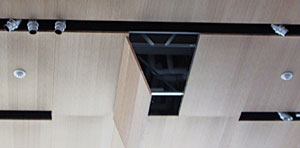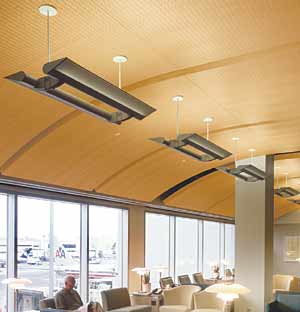Perforated Metal and Wood Ceilings: Sustainability, Acoustics, and Aesthetics
Certified Wood (LEED Credit MR-7): To encourage environmentally responsible forest management, wood ceilings can be made with veneers from sources certified to maintain sustainable forests. For assurance that wood products delivered to a project are actually from sustainable forests, the ceiling fabricator must prepare a chain-of-custody certificate for wood building components.
Low-Emitting Materials, Composite Wood(LEED Credit EQ-4.4): Whether made from trees or bamboo, the new wood panels contain no added urea-formaldehyde resins in either the aluminum core or the glues used to laminate the veneers.
|
OTHER LEED CREDITS
Ceilings are also a critical consideration to meet acoustical requirements under the LEED For Schools program. More, the performance of a ceiling system has a significant impact on a number of other criteria within the LEED program, even if the ceiling itself is not the direct basis for evaluating claims for LEED credits. For example:
Building Systems Commissioning, Measurement and Verification (LEED Prerequisite EA-1 and Credit EA-5): For optimum energy efficiency, HVAC and other building systems must be readily accessible for adjustment and maintenance. This means that ceilings must allow access to mechanical or electrical equipment located above the ceiling and that ceiling panels must be easily removable and resilient enough to be handled without damage.
|
While lay-in grid ceilings allow panels to be removed and replaced, conventional mineral fiber panels are frangible and can be easily damaged. And traditional wood ceilings allow only limited access because such panels are heavy.
These limitations have been overcome by the new generation of metal and wood ceilings. These ceiling systems have exceptionally lightweight panels that reduce the effort required for installation and handling. Their light weight also makes it practical to use larger-than-normal panels to permit improved access to above ceiling equipment. They are mounted onto a concealed grid with torsion springs that allow panels to swing out of the way or to be removed and replaced without special tools.
Improved Energy Performance (LEED Prerequisite EA-2 and Credit EA-1): Lighting accounts for an estimated 20 to 25 percent of annual energy consumption in the United States. Improving the light reflectance of ceilings can help conserve this energy. Depending on the finish selected, metal ceilings can provide outstanding light reflectance values. The highest levels of reflectance are provided by polished metals with mirror-like finishes. While these are visually exciting, they create too much glare for use in most spaces. Instead, a light-colored matte finish should be used to diffuse light and create conditions for better visual acuity.
Indirect lighting can often provide better-quality, glare-free illumination than old-style troffer luminaires. Panels perforations are also ideal for inserting small LED lamps. Their performance, however, depends upon having a reflective ceiling that will diffuse light uniformly. In addition, a ceiling must be easy to clean to prevent degradation of the lighting.











